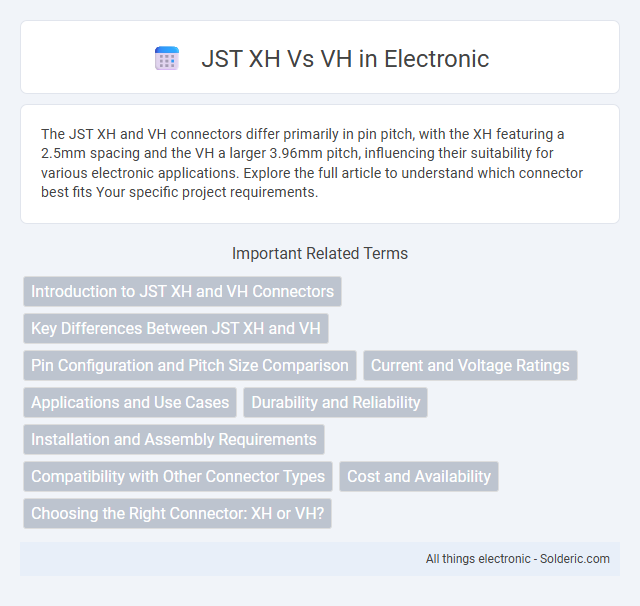The JST XH and VH connectors differ primarily in pin pitch, with the XH featuring a 2.5mm spacing and the VH a larger 3.96mm pitch, influencing their suitability for various electronic applications. Explore the full article to understand which connector best fits Your specific project requirements.
Comparison Table
| Feature | JST XH | JST VH |
|---|---|---|
| Pitch | 2.5 mm | 3.96 mm |
| Contact Type | Pin Contacts | Pin Contacts |
| Current Rating | 3 A | 3 A |
| Voltage Rating | 250 V AC/DC | 250 V AC/DC |
| Housing Type | Insulation Barrier with Lock | Insulation Barrier with Lock |
| Typical Applications | Consumer Electronics, PCBs | Industrial Equipment, High Power Applications |
| Mounting | Through-Hole PCB | Through-Hole PCB |
| Number of Positions | 2 to 16 Pins | 2 to 15 Pins |
| Durability | 30 mating cycles | 30 mating cycles |
Introduction to JST XH and VH Connectors
JST XH and VH connectors are widely used in electronic applications for reliable wire-to-board connections. The XH series features a 2.5mm pitch and is commonly employed in compact devices, offering a secure locking mechanism and ease of assembly. VH connectors, with a larger 3.96mm pitch, provide higher current capacity and are typically utilized in power or industrial equipment where robust connections are essential.
Key Differences Between JST XH and VH
JST XH connectors feature a 2.5mm pitch, while JST VH connectors have a larger 3.96mm pitch, making them incompatible for direct replacement. The XH series is commonly used in compact electronic devices due to its smaller size, whereas VH connectors are preferred for applications requiring higher current capacity and durability, such as power supply connections. Understanding these key differences ensures your choice aligns with the electrical and spatial requirements of your project.
Pin Configuration and Pitch Size Comparison
JST XH connectors feature a 2.5mm pitch size, making them slightly larger than the 2.54mm pitch found in JST VH connectors, which affects their compatibility with PCB layouts. The pin configuration of JST XH includes a single-row arrangement suitable for moderate power connections, whereas JST VH offers a more compact single-row setup designed primarily for signal wiring in tighter spaces. Understanding these differences ensures your choice matches the required electrical specifications and mechanical fit for your project.
Current and Voltage Ratings
JST XH connectors have a current rating of up to 3A per contact with a voltage rating of 250V AC/DC, making them suitable for low to moderate power applications. In comparison, JST VH connectors are rated for higher currents, typically up to 10A per contact, and voltage ratings around 250V AC, making them ideal for higher power and industrial uses. The difference in current capabilities primarily arises from VH's larger contact size and pin spacing, which enhances thermal dissipation and electrical capacity.
Applications and Use Cases
JST XH connectors are widely used in consumer electronics and small PCB connections due to their compact size and 2.5mm pitch, making them ideal for battery packs, LED lighting, and hobbyist projects. JST VH connectors feature a larger 3.96mm pitch and are commonly employed in industrial equipment and power applications, offering higher current capacity and sturdier locking mechanisms. The choice between XH and VH series depends on voltage requirements, space constraints, and the mechanical robustness needed for specific use cases.
Durability and Reliability
JST XH connectors offer moderate durability with a rated operating temperature of -25degC to 85degC and a 500 mating cycle lifespan, making them reliable for standard electronic applications. VH connectors provide enhanced durability, supporting operating temperatures up to 125degC and a higher mating cycle rating of around 1000 cycles, ensuring greater reliability in more demanding environments. The robust housing and contact design of VH connectors reduce failure rates in high-vibration or high-temperature conditions compared to the XH series.
Installation and Assembly Requirements
JST XH connectors require precise alignment during installation to ensure secure pin engagement, typically used in low-current applications with a 2.5mm pitch that mandates careful wire insertion and soldering. JST VH connectors feature a larger 3.96mm pitch, allowing easier handling and assembly, with a design that supports higher current loads and requires robust mounting to prevent disconnection under mechanical stress. Both connector types demand compatible headers and crimp terminals, but the VH's larger size and structural stability often simplify assembly in industrial or automotive environments.
Compatibility with Other Connector Types
JST XH connectors offer broad compatibility with various PCB connectors due to their 2.5mm pitch, making them suitable for applications requiring moderate current and space efficiency. In contrast, JST VH connectors have a larger 3.96mm pitch, limiting their integration with smaller connector types but providing better mechanical stability for heavier gauge wires. Your choice depends on the need to match connector pitch and wiring specifications for seamless interfacing with existing systems or devices.
Cost and Availability
JST XH connectors are widely available and cost-effective, making them a popular choice for budget-conscious projects and mass production. VH connectors, while offering higher current ratings and durability, tend to be more expensive and less commonly stocked by distributors. Your decision between JST XH and VH will depend on balancing price constraints against the need for robust, high-current connections.
Choosing the Right Connector: XH or VH?
Selecting between JST XH and VH connectors depends on your project's current and space requirements. JST XH connectors support up to 3A current with a 2.5mm pitch, ideal for compact electronics, while VH connectors handle higher currents up to 8A with a 3.96mm pitch, suitable for power-intensive applications. Understanding your device's voltage needs and available space ensures your choice maximizes performance and reliability.
JST XH vs VH Infographic

 solderic.com
solderic.com